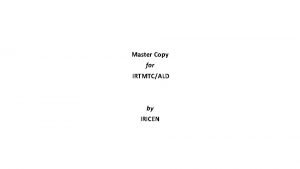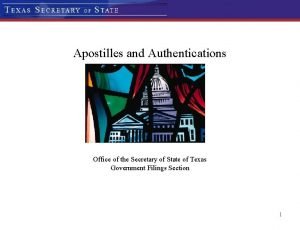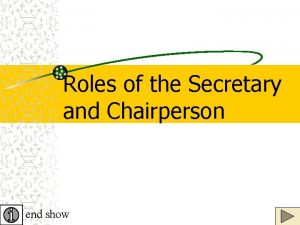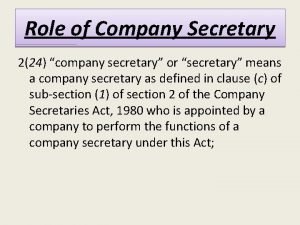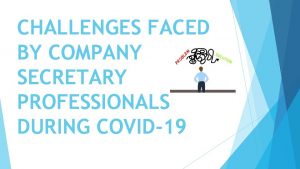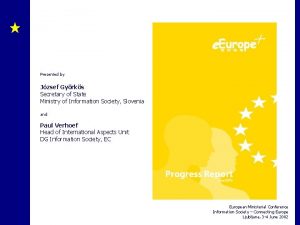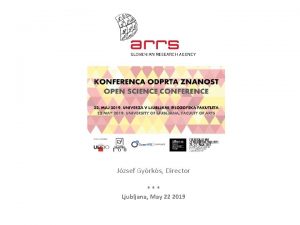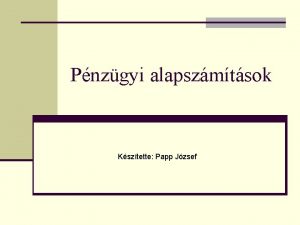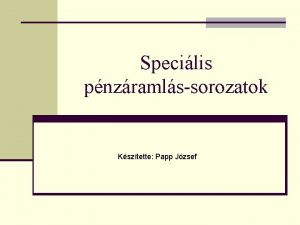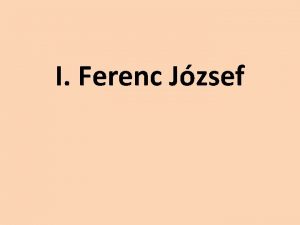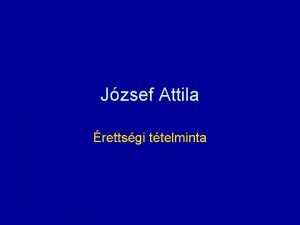Jzsef GYRKS STATE SECRETARY Strategy of V 4














- Slides: 14

József GYÖRKÖS STATE SECRETARY Strategy of V 4+ Countries: Slovenia V 4 DIS, Hradec Kralove, March 29, 2004

Key Issues Addressed I. Information Society Indicators II. Structural funds III. Achieving Participation by Access to the Public Sector information IV. Specific e-Government Initiatives I. INFORMATION SOCIETY INDICATORS http: //mid. gov. si

Regulatory Framework of “e-Slovenia” Strategy of Republic of Slovenia in Information Society Strategy of e-local government Broadband Strategy Acts: • on Electronic commerce and electronic signature (ZEPEP-1) + decree • on author rights (ZASP) • on protection of personal data (ZVOP) • on consumer rights (ZVpot) • on Access to public sector information (ZDIJZ) • on Electronic Communications • on Integration of public legal registries (ZPJE) http: //mid. gov. si

Ministerial conference EMCIS, June 2002 Ljubljana, http: //emcis. gov. si I. INFORMATION SOCIETY INDICATORS Ministerial conference EMCIS, Budapest, February 2004 http: //www. emcis 2004. hu http: //mid. gov. si

Catching up with EU: Decreasing interconnection prices (EU par level) Internet penetration Internet access in households * EU 2003 estimate I. INFORMATION SOCIETY INDICATORS http: //mid. gov. si

SI vs. EU I. INFORMATION SOCIETY INDICATORS http: //mid. gov. si

II. Structural funds The SPD (Single Programming Document) for Slovenia defines the development of information society as horizontal priority; all measures have to take full advantage of IS services in terms of eligibility and in terms of improving access, use and affordability of ICT. Measures (a selection of): a) modernising the public sector; b) stimulating demand in the private sector; c) developing content; d) rising digital skills; e) upgrade ICT infrastructure that will secure high-speed broad band internet connectivity. II. STRUCTURAL FUNDS http: //mid. gov. si

Priority No. 1: Promoting the productive sector and competitiveness ERDF: European Regional Development Fund Ministry for Economy 1. 1. Innovative environment 1. 2. Promoting the development of tourist destinations 1. 3. Improving the enterprise support environment EAGGF: European Agricultural Guidance and Guarantee Fund 1. 4. Investment in agricultural economy 1. 5. Improving production and marketing of agricultural products 1. 6. Promoting agriculture-related activities – alternative sources of income 1. 7. Marketing quality agricultural products Priority No. 2: Knowledge, human resource development and employment ESF: Ministry for labour, Family and Social Affairs 2. 1. 2. 2. 2. 3. 2. 4. Developing and promoting active labour market policies Facilitating Social Inclusion Lifelong Learning Fostering Enterpreneurship and Adaptability Priority No. 3: Economic infrastructure Developing business and industrial zones II. STRUCTURAL FUNDS http: //mid. gov. si

III. Achieving Participation by Access to the Public Sector Information Drivers of participation Avoiding, reducing the influence of DIGITAL DIVIDE Right to each person to acquire the information held by public body Increased role of the local authorities - the Cities’ Governments • • • ICT Infrastructure ICT Applications in Public Sector e. Security e. Business into Administration e. Literacy III. ACHIEVING PARTICIPATION http: //mid. gov. si

The public access to information act • defines public bodies responsible for providing the information; according to this provision public bodies are all legislative, executive and judicial authorities on national, regional or local level, public agencies, public founds, bodies governed by public law an other bodies exercising a public authority; • provides also a more comprehensive, but what is more important an unified understanding of what are public sector information, basically by excluding certain types of information (this » negative interpretation « approach could certainly be criticised, yet it is perhaps the only compromise which guarantees the respect of other fundamental freedoms – such as for instance personal data); III. ACHIEVING PARTICIPATION http: //mid. gov. si

The public access to information act • imposes the obligation on public bodies to provide all public sector information, held by a particular public body, on the internet; • to implement the obligation from the previous paragraph each public body is obliged to establish a catalogue of public sector information administred by the public body which is the main framework for the provision of public sector information; • defines the procedure of access of individuals to public sector information; • guarantees a free of charge insight and a charge restriction for transcript limited only to material costs; III. ACHIEVING PARTICIPATION http: //mid. gov. si

IV. Specific e-Government Initiatives E-gov - in average assessed as improving procurement regarding ICT - registry of legislation and full texts of acts Public can be carried out on-line (level 3). is available on-line and free of charge - huge complexity: large number of autonomous players; data-source integration at the service level is needed (still lacks at the information stage, at the same time transaction stage is under development) ! IV. E-GOV INITIATIVES http: //mid. gov. si

Selected G 2 B Projects A project of the Small Business Development Centre (SBDC), cofinanced by Ministry of Information Society, deals with empowering local e -business reference centres to help SMEs incorporate e-business into their strategies, as well as to build on new business models. The development of (anti-bureaucratic) one-stop shop - the VEM project is to have substantial impact on lowering the administrative burdens for SMEs. The project is threefold and foresees simplification and acceleration of business set-up process, its formal registering and statutory changes, all at one stop-shop. Future functionalities of the one-stop-shop additionally foresee acquiring of permits and licences, as well as ereporting of companies to state bodies. VEM project, estimated at 2, 67 M€, will be co-financed through Phare programme (2 M€). Several projects that are running in Slovenia tackle the interoperability issues. Two of most promising are the e-SLOG and E-Co. RE projects. The first one is run by Chamber of Commerce and deals with setting up a number of common business documents, such as invoice or payment order, in electronic form using XML. IV. E-GOV INITIATIVES http: //mid. gov. si

DR. JÓZSEF GYÖRKÖS STATE SECRETARY jozsef. gyorkos@gov. si http: //mid. gov. si
 Ptvi1
Ptvi1 Texas apostille form 2102
Texas apostille form 2102 Company secretary meaning
Company secretary meaning Company secretary meaning
Company secretary meaning Secdef executive fellowship
Secdef executive fellowship Roles of a secretary before a meeting
Roles of a secretary before a meeting Role of company secretary
Role of company secretary Respiratory airway secretary
Respiratory airway secretary Present perfect question tag
Present perfect question tag Role of company secretary
Role of company secretary Aiesec czech republic
Aiesec czech republic Secretary soft skills
Secretary soft skills Only individuals can be secretaries
Only individuals can be secretaries Challenges of company secretary
Challenges of company secretary Challenges faced by company secretary during lockdown
Challenges faced by company secretary during lockdown
